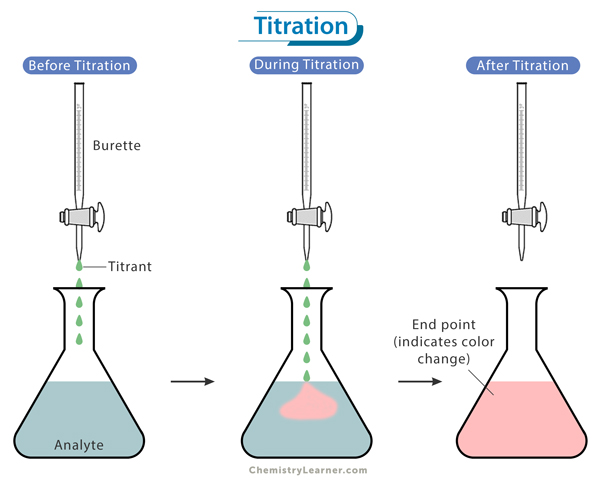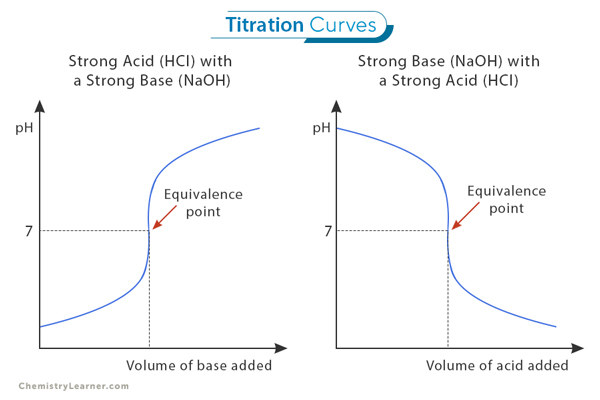Titration
Titration is a widely used technique to measure the amount of one substance present in another through a chemical reaction. It is commonly used in analytical chemistry to determine the concentration of a substance in a solution. [1-4]
Principle
Titration involves the gradual addition of a reagent of known concentration, known as the titrant, to a solution whose concentration needs to be determined, known as the analyte. This process continues until stoichiometrically equivalent amounts of the reactants have been mixed, and an endpoint known as the equivalence point has been reached. Stoichiometrically equivalent refers to the condition where the quantities of reactants in a chemical reaction are present in exact proportions according to the balanced chemical equation, ensuring that they completely react with each other without any excess of one reactant. [1,2,4,5,7]
The endpoint is typically indicated by a color change or other observable change, which signifies that the reaction between the analyte and titrant is complete. By carefully measuring and recording the volume of titrant required to reach this endpoint, along with its known concentration, it is possible to calculate the concentration or amount of analyte present in the original solution using stoichiometry and mathematical calculations.
Titration Procedure
A precisely measured volume of the analyte is placed in a flask or beaker to initiate the titration. A burette, calibrated to dispense the titrant, is accurately filled. The titrant is then gradually added to the analyte while constantly swirling the flask to ensure uniform mixing. This slow addition allows for careful observation of changes occurring in the solution, such as color shifts or abrupt pH alterations. Before beginning the titration, a buffer solution may be added to stabilize the pH, particularly in reactions sensitive to slight pH changes [2,4]
It is crucial to approach the endpoint cautiously during titration, adding the titrant drop by drop near the anticipated endpoint. This meticulousness ensures accuracy in determining the exact volume of titrant needed to reach the endpoint. Upon reaching the endpoint, the volume of titrant used is recorded. Multiple titrations may be performed to ensure precision, and the average volume of titrant required is calculated to determine the concentration of the analyte using the titration equation.
Titration Curve
The titration curve is a graphical representation of the pH or other property changes during a titration experiment. It provides valuable information about the reaction under study and helps understand the results obtained. [2,3,5]
When interpreting a titration curve, it is essential to understand its key features. One such feature is the inflection point, a point on the curve where the pH changes quickly, showing that the reaction is nearly complete. The inflection point often corresponds to the equivalence point, where the stoichiometrically equivalent amounts of reactants have reacted. The pH change and the location of the equivalence point are indicated in the image below.
At the inflection point, all of one reactant has reacted with all of another, resulting in either neutralization or precipitate formation. Therefore, identifying and analyzing this inflection point allows for accurately determining reaction stoichiometry and concentration calculations.
The buffering region on a titration curve refers to the area where the pH remains relatively stable despite the addition of the titrant. This region occurs around the titration’s equivalence point when the titrant and analyte amount are nearly equal. Valuable information about buffering capacity and acid-base behavior (in the case of acid-base titration) can be obtained by examining the shape and slope of the titration curve before and after the inflection point. The steepness or gradualness of these regions indicates how quickly or slowly the pH changes with the addition of titrant.
Formula
The concentration of analyte may then be calculated using the following formula: [7]
Ca = (Ct × Vt × M)/Va
Where:
- Ca is the analyte concentration in molarity
- Ct is the titrant concentration in molarity
- Vt is the titrant volume in liters
- M is the mole ratio between the analyte and titrant from the balanced chemical equation
- Va is the volume of an analyte in liters
Types of Titrations
Mentioned below are the several types of titrations. Each type has unique principles, applications, and suitable scenarios for precise analysis. [2,4,5]
- Acid-Base Titration: Involves the neutralization of an acid with a base (or vice versa) using a pH indicator to determine the endpoint.
- Redox Titration: Measures the transfer of electrons between reactants, often using an oxidizing or reducing agent to determine the equivalence point.
- Complexometric Titration: Utilizes complex formation between metal ions and complexing agents, often employing indicators or electrodes for endpoint detection.
- Precipitation Titration: Determines the concentration of analytes by forming a precipitate, often using a known reagent to induce precipitation and measure the endpoint.

